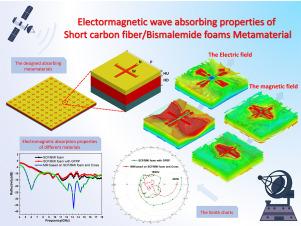Electromagnetic wave absorbing properties of Short carbon fiber/Bismaleimide foams Metamaterial
IF 3.9
3区 材料科学
Q2 MATERIALS SCIENCE, MULTIDISCIPLINARY
引用次数: 0
Abstract
The development of broadband electromagnetic wave absorbing materials often faces challenges due to constraints such as thickness and mechanical integrity. To address these issues, this study has engineered and fabricated a Short Carbon Fiber (SCF)/Bismaleimide (BMI) foam Metamaterial (MM). This composite is composed of a crosshatch metal pattern, reinforced with glass fiber plastic (GFRP), and a BMI foam matrix infused with SCF as a functional filler. The electromagnetic field distribution and input impedance analysis indicate that the crosshatch metal pattern is adept at modulating the impedance of the SCF/BMI foam, thereby influencing the field distribution. This material demonstrates superior absorption characteristics, with reflectivity levels below −10 dB across the 5–18 GHz frequency range, achieved with a mere 4.7 mm thickness. Moreover, the designed material maintains outstanding performance even under oblique incidence, and it exhibits commendable thermal stability and mechanical robustness. The findings suggest that the proposed SCF/BMI foam MM has promising potential for applications in radar stealth technology for various targets.

短碳纤维/双马来酰亚胺泡沫超材料的电磁波吸收特性
由于厚度和机械完整性等限制,宽带电磁波吸收材料的开发往往面临挑战。为了解决这些问题,本研究设计并制造了一种短碳纤维(SCF)/双马来酰亚胺(BMI)泡沫超材料(MM)。这种复合材料由玻璃纤维塑料 (GFRP) 加固的十字划痕金属图案和注入 SCF 作为功能填料的 BMI 泡沫基质组成。电磁场分布和输入阻抗分析表明,十字划痕金属图案善于调节 SCF/BMI 泡沫的阻抗,从而影响电磁场分布。这种材料表现出卓越的吸收特性,在 5-18 GHz 频率范围内的反射率低于 -10 dB,厚度仅为 4.7 毫米。此外,所设计的材料即使在斜入射条件下也能保持出色的性能,并表现出令人称道的热稳定性和机械坚固性。研究结果表明,所提出的 SCF/BMI 泡沫 MM 在雷达隐形技术中对各种目标的应用具有广阔的前景。
本文章由计算机程序翻译,如有差异,请以英文原文为准。
求助全文
约1分钟内获得全文
求助全文
来源期刊

Materials Science and Engineering: B
工程技术-材料科学:综合
CiteScore
5.60
自引率
2.80%
发文量
481
审稿时长
3.5 months
期刊介绍:
The journal provides an international medium for the publication of theoretical and experimental studies and reviews related to the electronic, electrochemical, ionic, magnetic, optical, and biosensing properties of solid state materials in bulk, thin film and particulate forms. Papers dealing with synthesis, processing, characterization, structure, physical properties and computational aspects of nano-crystalline, crystalline, amorphous and glassy forms of ceramics, semiconductors, layered insertion compounds, low-dimensional compounds and systems, fast-ion conductors, polymers and dielectrics are viewed as suitable for publication. Articles focused on nano-structured aspects of these advanced solid-state materials will also be considered suitable.
 求助内容:
求助内容: 应助结果提醒方式:
应助结果提醒方式:


